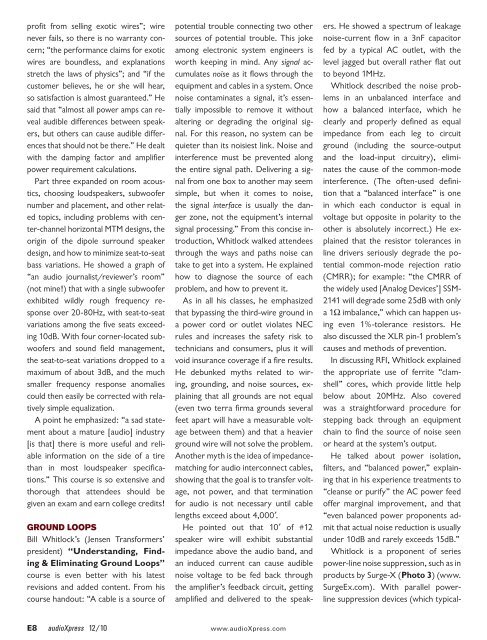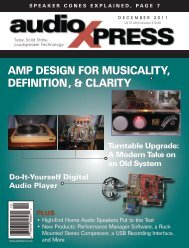A TUNE-UP FOR THE DUAL TURNTABLE - ThaiHDbox
A TUNE-UP FOR THE DUAL TURNTABLE - ThaiHDbox
A TUNE-UP FOR THE DUAL TURNTABLE - ThaiHDbox
You also want an ePaper? Increase the reach of your titles
YUMPU automatically turns print PDFs into web optimized ePapers that Google loves.
profit from selling exotic wires”; wire<br />
never fails, so there is no warranty concern;<br />
“the performance claims for exotic<br />
wires are boundless, and explanations<br />
stretch the laws of physics”; and “if the<br />
customer believes, he or she will hear,<br />
so satisfaction is almost guaranteed.” He<br />
said that “almost all power amps can reveal<br />
audible differences between speakers,<br />
but others can cause audible differences<br />
that should not be there.” He dealt<br />
with the damping factor and amplifier<br />
power requirement calculations.<br />
Part three expanded on room acoustics,<br />
choosing loudspeakers, subwoofer<br />
number and placement, and other related<br />
topics, including problems with center-channel<br />
horizontal MTM designs, the<br />
origin of the dipole surround speaker<br />
design, and how to minimize seat-to-seat<br />
bass variations. He showed a graph of<br />
“an audio journalist/reviewer’s room”<br />
(not mine!) that with a single subwoofer<br />
exhibited wildly rough frequency response<br />
over 20-80Hz, with seat-to-seat<br />
variations among the five seats exceeding<br />
10dB. With four corner-located subwoofers<br />
and sound field management,<br />
the seat-to-seat variations dropped to a<br />
maximum of about 3dB, and the much<br />
smaller frequency response anomalies<br />
could then easily be corrected with relatively<br />
simple equalization.<br />
A point he emphasized: “a sad statement<br />
about a mature [audio] industry<br />
[is that] there is more useful and reliable<br />
information on the side of a tire<br />
than in most loudspeaker specifications.”<br />
This course is so extensive and<br />
thorough that attendees should be<br />
given an exam and earn college credits!<br />
GROUND LOOPS<br />
Bill Whitlock’s (Jensen Transformers’<br />
president) “Understanding, Finding<br />
& Eliminating Ground Loops”<br />
course is even better with his latest<br />
revisions and added content. From his<br />
course handout: “A cable is a source of<br />
potential trouble connecting two other<br />
sources of potential trouble. This joke<br />
among electronic system engineers is<br />
worth keeping in mind. Any signal accumulates<br />
noise as it flows through the<br />
equipment and cables in a system. Once<br />
noise contaminates a signal, it’s essentially<br />
impossible to remove it without<br />
altering or degrading the original signal.<br />
For this reason, no system can be<br />
quieter than its noisiest link. Noise and<br />
interference must be prevented along<br />
the entire signal path. Delivering a signal<br />
from one box to another may seem<br />
simple, but when it comes to noise,<br />
the signal interface is usually the danger<br />
zone, not the equipment’s internal<br />
signal processing.” From this concise introduction,<br />
Whitlock walked attendees<br />
through the ways and paths noise can<br />
take to get into a system. He explained<br />
how to diagnose the source of each<br />
problem, and how to prevent it.<br />
As in all his classes, he emphasized<br />
that bypassing the third-wire ground in<br />
a power cord or outlet violates NEC<br />
rules and increases the safety risk to<br />
technicians and consumers, plus it will<br />
void insurance coverage if a fire results.<br />
He debunked myths related to wiring,<br />
grounding, and noise sources, explaining<br />
that all grounds are not equal<br />
(even two terra firma grounds several<br />
feet apart will have a measurable voltage<br />
between them) and that a heavier<br />
ground wire will not solve the problem.<br />
Another myth is the idea of impedancematching<br />
for audio interconnect cables,<br />
showing that the goal is to transfer voltage,<br />
not power, and that termination<br />
for audio is not necessary until cable<br />
lengths exceed about 4,000�.<br />
He pointed out that 10� of #12<br />
speaker wire will exhibit substantial<br />
impedance above the audio band, and<br />
an induced current can cause audible<br />
noise voltage to be fed back through<br />
the amplifier’s feedback circuit, getting<br />
amplified and delivered to the speak-<br />
E8 audioXpress 12/10 www.audioXpress.com<br />
ers. He showed a spectrum of leakage<br />
noise-current flow in a 3nF capacitor<br />
fed by a typical AC outlet, with the<br />
level jagged but overall rather flat out<br />
to beyond 1MHz.<br />
Whitlock described the noise problems<br />
in an unbalanced interface and<br />
how a balanced interface, which he<br />
clearly and properly defined as equal<br />
impedance from each leg to circuit<br />
ground (including the source-output<br />
and the load-input circuitry), eliminates<br />
the cause of the common-mode<br />
interference. (The often-used definition<br />
that a “balanced interface” is one<br />
in which each conductor is equal in<br />
voltage but opposite in polarity to the<br />
other is absolutely incorrect.) He explained<br />
that the resistor tolerances in<br />
line drivers seriously degrade the potential<br />
common-mode rejection ratio<br />
(CMRR); for example: “the CMRR of<br />
the widely used [Analog Devices’] SSM-<br />
2141 will degrade some 25dB with only<br />
a 1� imbalance,” which can happen using<br />
even 1%-tolerance resistors. He<br />
also discussed the XLR pin-1 problem’s<br />
causes and methods of prevention.<br />
In discussing RFI, Whitlock explained<br />
the appropriate use of ferrite “clamshell”<br />
cores, which provide little help<br />
below about 20MHz. Also covered<br />
was a straightforward procedure for<br />
stepping back through an equipment<br />
chain to find the source of noise seen<br />
or heard at the system’s output.<br />
He talked about power isolation,<br />
filters, and “balanced power,” explaining<br />
that in his experience treatments to<br />
“cleanse or purify” the AC power feed<br />
offer marginal improvement, and that<br />
“even balanced power proponents admit<br />
that actual noise reduction is usually<br />
under 10dB and rarely exceeds 15dB.”<br />
Whitlock is a proponent of series<br />
power-line noise suppression, such as in<br />
products by Surge-X (Photo 3) (www.<br />
SurgeEx.com). With parallel powerline<br />
suppression devices (which typical-



